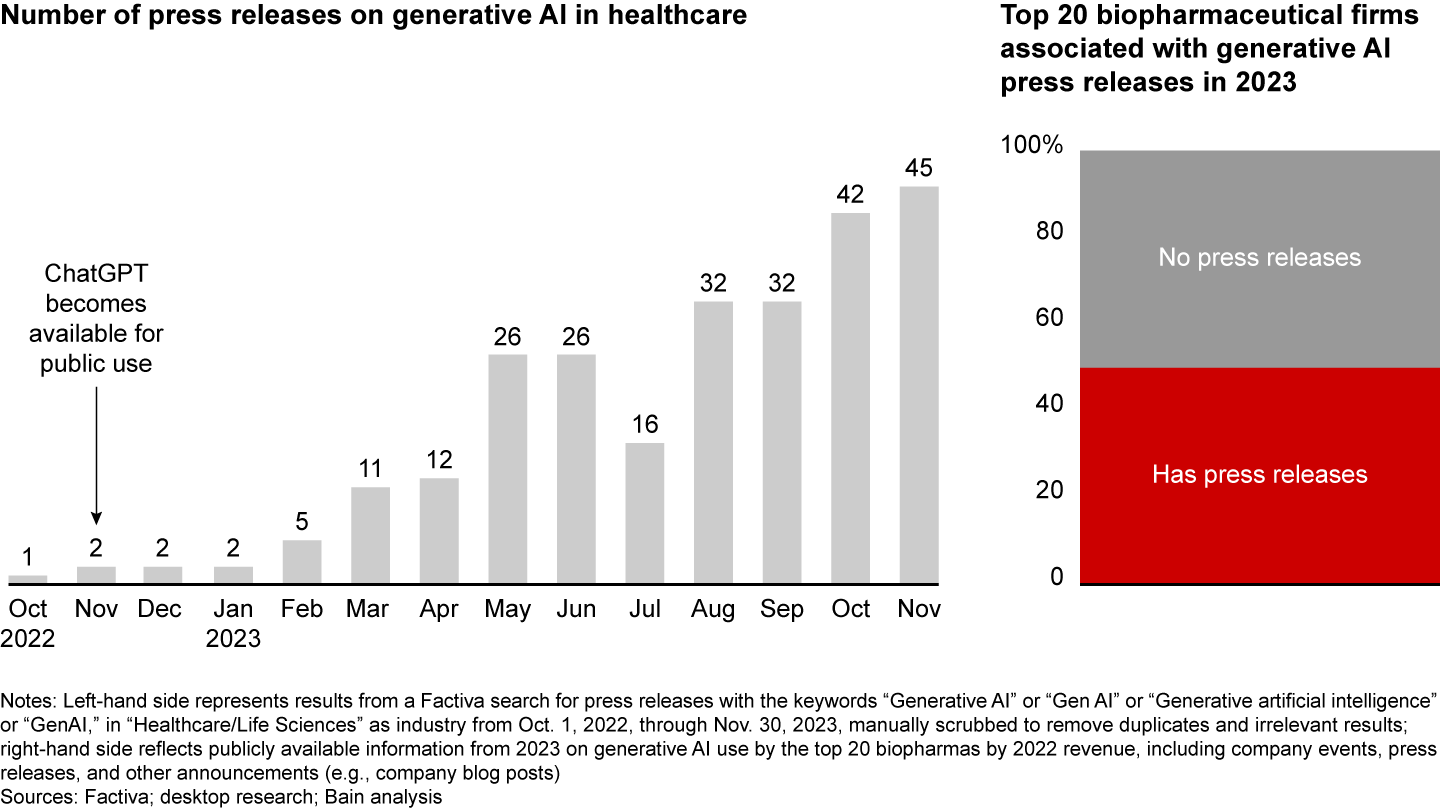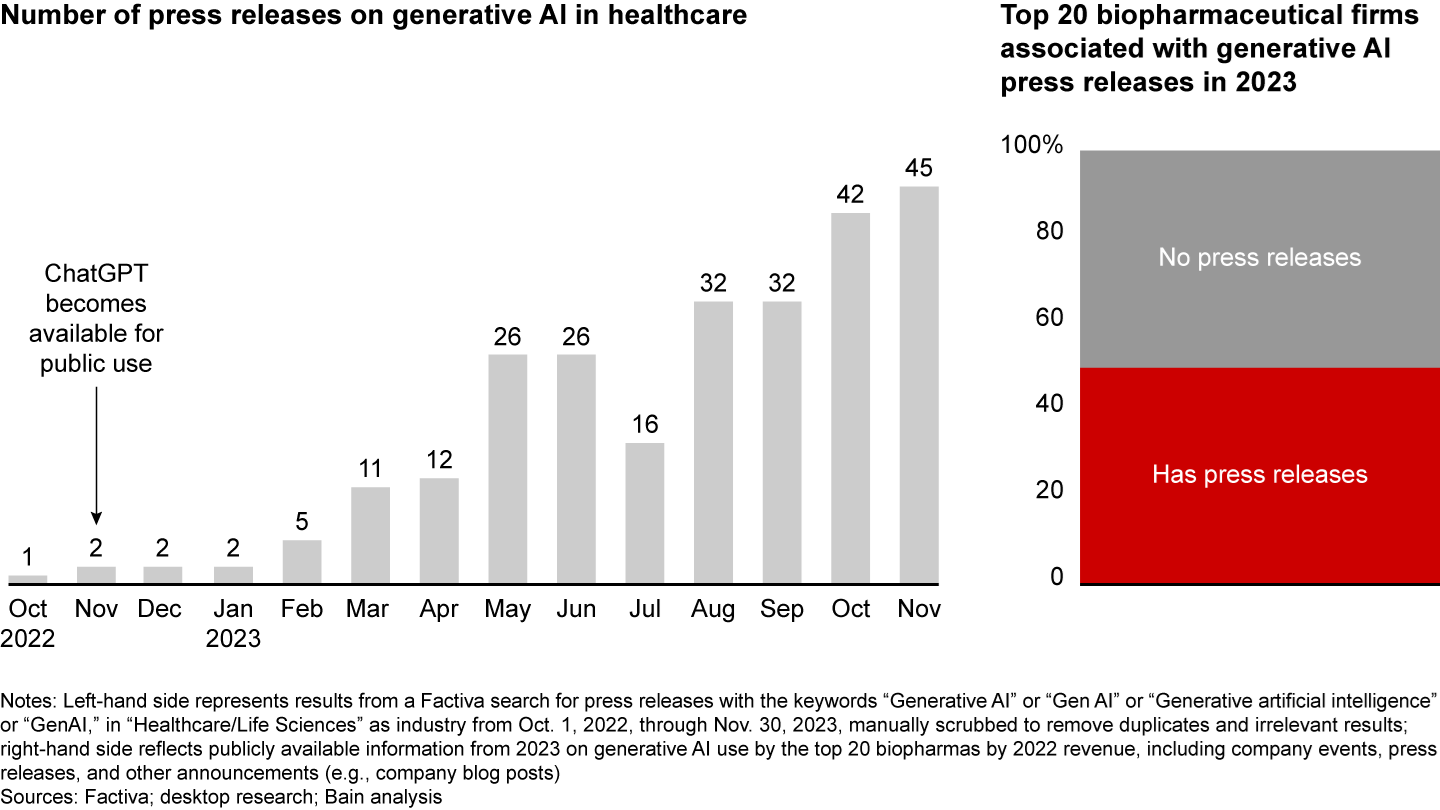Global Healthcare Private Equity Report

At a Glance
- Generative AI promises to drive significant productivity gains, improve patient and provider experience, and ultimately lead to better clinical outcomes.
- The technology could lower administrative costs, speed biomedical research and drug development, improve claims management, and help develop next-generation diagnostic equipment.
- Big technology companies are partnering with healthcare organizations to apply generative AI, and investors are deploying capital in nascent companies built around the tool.
- Investors need to consider generative AI’s disruptive potential on portfolio companies and new investments, and identify opportunities to take advantage of the technology.
Este artigo faz parte do Relatório de Fusões e Aquisições de 2023 da Bain.
Foundation models, large language models (LLMs), and generative artificial intelligence (AI) captured the attention of providers, biopharmas, payers, and investors over the past year, driven by the promise of making healthcare delivery more efficient, innovative, and effective (see Figure 1). While traditional, analytical AI has been used in healthcare for many years, generative AI is distinguished by its ability to create new content, summarize and translate existing content, and, ultimately, to “reason and plan.”
The technology has potential across many use cases, including these:
- For providers and in care delivery, it promises to cut the time spent on documenting patient visits and reimbursement-related communications, which would reduce clinician burnout and lower administrative costs. Indeed, organizations such as HCA Healthcare are pursuing these opportunities via partnerships with tech companies such as Google, in part because patients may already be changing their behavior, using off-the-shelf tools to understand and inform their interactions with clinicians.
- In biomedical research and drug development, generative AI is speeding innovation, as evidenced by the strategic alliance between Sanofi and BioMap, where Sanofi will use BioMap’s AI platform to optimize the process of drug discovery. Molecular biology-specific LLMs are also supporting predictive modeling of protein structure and target-binding affinity, in addition to the creation of therapeutic candidates themselves.
- Insurers and other payers have long made use of AI in data analytics, claims management automation and adjudication, and quality and risk management. Now, they are implementing generative AI for member navigation, an example being UnitedHealth Group’s virtual assistant for patient communication.
- Medtech companies, meanwhile, are focusing their investments on next-generation diagnostic equipment to detect diseases via AI-enabled hardware, surgical robots with AI-powered systems, or smart remote-monitoring devices. For example, Philips is partnering with Amazon Web Services to develop generative AI to advance the company’s PACS image processing and enhance radiology workflows, as part of its broader AI efforts in diagnosis and treatment, connected care, and personal health.
- As foundation models, computer vision, and other areas continue to mature, all types of healthcare organizations will find opportunities to apply generative AI to support operations across the value chain (such as supply chain management and back-office activities).
Ultimately, generative AI may reshape healthcare institutions’ core functional areas, presenting an opportunity for investors to serve changing markets and adjust operations within existing portfolio companies.


A nascent stage of investment
Healthcare investment in generative AI has just begun.
Technology companies are collaborating with major healthcare organizations to apply generative AI tools. For instance, Microsoft and Epic have teamed up to reduce the time clinicians spend documenting or replying to patient messages. Google is working with Bayer to automate drafting of clinical trial communications in multiple languages and is partnering with iCad to integrate AI tools in the company’s devices to detect breast cancer. IBM is working with Microsoft Azure to analyze complex medical records. Ultimately, healthcare information technology vendors are at the forefront of using generative AI, marrying the technology with their extensive networks of providers and users.
Among investors, venture capital and growth equity funds have been deploying capital in companies built around generative AI as a core competency. For example, Hippocratic AI, a healthcare-focused LLM company, raised $50 million in a seed round co-led by General Catalyst and Andreessen Horowitz. Genesis Therapeutics, a drug discovery platform that uses generative AI to pinpoint novel drug candidates, closed a $200 million series B round, with participation from Andreessen Horowitz, Fidelity, and BlackRock.
Mature private equity (PE)-backed companies are also investing in LLMs to drive operational improvement in various areas including better clinician or patient engagement and lower cost structures. For example, Syneos Health, taken private by Elliott, Patient Square, and Veritas, entered into a multiyear deal with Microsoft to leverage OpenAI’s ChatGPT in clinical trials and commercial programs. Similarly, Advent-backed Iodine Software has partnered with OpenAI to infuse LLMs into its AwareCDI product suite to improve the software’s accuracy and efficiency.
The effects on portfolio companies and new investments
To get ahead of this rapidly evolving technology, PE investors must carefully consider the impact of generative AI on their portfolio companies. Primarily, they need to assess the exposure of their portfolio companies’ markets to generative AI disruption, paying attention to both the magnitude and timing of any potential threats or opportunities. Bain has developed a framework to gauge disruption risk, which assesses labor intensity, level of knowledge required to perform tasks, the type and frequency of interactions with humans, and the value of augmented pattern recognition, among other variables.
Businesses where the following are core elements of the value proposition face greater risk: creative content generation, labor-intensive administrative processes and call center work, and text-writing and summarization. For example, business process outsourcers that employ low-skilled labor to generate communication for medical claims and denials may be places where generative AI can automate or accelerate the processes. On the other hand, in healthcare businesses that rely on expert guidance, such as physicians providing clinical recommendations, the technology poses less of a risk for disruption, but instead may be viewed as an opportunity to democratize access and improve quality.
In deploying generative AI at portfolio companies, investors should develop a focused strategy with three key elements:
- identifying opportunities to leverage commercially available generative AI tools;
- consider building proprietary generative AI software where there is an opportunity to establish competitive differentiation; and
- defining generative AI governance and guardrails to ensure its proper use, such as update policies and data security.
Similarly, investors should consider the implications of generative AI for new investments’ deal theses, determining the disruption risk of generative AI and the potential for generative AI to unlock value, as part of due diligence and value-creation planning.
The long-term potential of generative AI
Given the complexity and uniqueness of patient situations, much of the work in healthcare requires human labor and judgment. Even areas where less discretion is needed, such as coding, charting, and registry extracts, have seen limited impact from AI models due to relatively small data sets available to train the algorithms. Generative AI promises to address some of these challenges, and experiments will likely proliferate in the year ahead. These efforts and early use cases have the potential to trigger strong labor efficiency gains—addressing the financial pressures on organizations, improving the patient and provider experience, and leading to better clinical outcomes.
We expect progress over the next year to come in select and focused use cases. Over a longer time frame, the breadth and depth of generative AI’s impact on healthcare may well be transformative across workflows, applications, and ways of working. Investors who are thoughtful about generative AI’s impact on their existing portfolio companies and new investments will be able to harness this technological change to generate returns and accelerate the transformation of the healthcare sector.
Este artigo faz parte do Relatório de Fusões e Aquisições de 2023 da Bain.